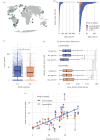Zygomorphic flowers have fewer potential pollinator species
- PMID: 32871089
- PMCID: PMC7532724
- DOI: 10.1098/rsbl.2020.0307
Zygomorphic flowers have fewer potential pollinator species
Abstract
Botanists have long identified bilaterally symmetrical (zygomorphic) flowers with more specialized pollination interactions than radially symmetrical (actinomorphic) flowers. Zygomorphic flowers facilitate more precise contact with pollinators, guide pollinator behaviour and exclude less effective pollinators. However, whether zygomorphic flowers are actually visited by a smaller subset of available pollinator species has not been broadly evaluated. We compiled 53 609 floral visitation records in 159 communities and classified the plants' floral symmetry. Globally and within individual communities, plants with zygomorphic flowers are indeed visited by fewer species. At the same time, zygomorphic flowers share a somewhat larger proportion of their visitor species with other co-occurring plants and have particularly high sharing with co-occurring plants that also have zygomorphic flowers. Visitation sub-networks for zygomorphic species also show differences that may arise from reduced visitor diversity, including greater connectance, greater web asymmetry and lower coextinction robustness of both plants and visitor species-but these changes do not necessarily translate to whole plant-visitor communities. These results provide context for widely documented associations between zygomorphy and diversification and imply that species with zygomorphic flowers may face a greater risk of extinction due to pollinator loss.
Keywords: ecological specialization; floral morphology; interaction networks; pollination.
Conflict of interest statement
The authors declare no competing interests.
Figures


Similar articles
-
Zygomorphic flowers last longer: the evolution of floral symmetry and floral longevity.Biol Lett. 2024 Jun;20(6):20240082. doi: 10.1098/rsbl.2024.0082. Epub 2024 Jun 19. Biol Lett. 2024. PMID: 38889773 Free PMC article.
-
The influence of floral symmetry, dependence on pollinators and pollination generalization on flower size variation.Ann Bot. 2014 Jul;114(1):157-65. doi: 10.1093/aob/mcu083. Epub 2014 May 17. Ann Bot. 2014. PMID: 24838838 Free PMC article.
-
Repeated evolution of a reproductive polyphenism in plants is strongly associated with bilateral flower symmetry.Curr Biol. 2021 Apr 12;31(7):1515-1520.e3. doi: 10.1016/j.cub.2021.01.009. Epub 2021 Feb 3. Curr Biol. 2021. PMID: 33539770
-
Floral zygomorphy, the recurring evolution of a successful trait.Bioessays. 2004 Nov;26(11):1175-84. doi: 10.1002/bies.20119. Bioessays. 2004. PMID: 15499590 Review.
-
Sex differences in pollinator behavior: Patterns across species and consequences for the mutualism.J Anim Ecol. 2019 Jul;88(7):971-985. doi: 10.1111/1365-2656.12988. Epub 2019 Apr 12. J Anim Ecol. 2019. PMID: 30921474 Review.
Cited by
-
Predation risk and floral rewards: How pollinators balance these conflicts and the consequences on plant fitness.Curr Res Insect Sci. 2024 Jul 17;6:100091. doi: 10.1016/j.cris.2024.100091. eCollection 2024. Curr Res Insect Sci. 2024. PMID: 39193177 Free PMC article. Review.
-
Rapid morphological change in UK populations of Impatiens glandulifera.Sci Rep. 2024 Aug 20;14(1):19275. doi: 10.1038/s41598-024-69710-y. Sci Rep. 2024. PMID: 39164340 Free PMC article.
-
Zygomorphic flowers last longer: the evolution of floral symmetry and floral longevity.Biol Lett. 2024 Jun;20(6):20240082. doi: 10.1098/rsbl.2024.0082. Epub 2024 Jun 19. Biol Lett. 2024. PMID: 38889773 Free PMC article.
-
Convergent evolutionary patterns of heterostyly across angiosperms support the pollination-precision hypothesis.Nat Commun. 2024 Feb 9;15(1):1237. doi: 10.1038/s41467-024-45118-0. Nat Commun. 2024. PMID: 38336937 Free PMC article.
-
Pollen nutrition structures bee and plant community interactions.Proc Natl Acad Sci U S A. 2024 Jan 16;121(3):e2317228120. doi: 10.1073/pnas.2317228120. Epub 2024 Jan 8. Proc Natl Acad Sci U S A. 2024. PMID: 38190523 Free PMC article.
References
-
- Takhtajan A. 1969. Flowering plants: origin and dispersal. Edinburgh, UK: Oliver & Boyd.
-
- Darwin C. 1877. The various contrivances by which orchids are fertilised by insects, 2nd edn New York, NY: D. Appleton and Company.
-
- Stebbins GL. 1974. Flowering plants: evolution above the species level. Cambridge, MA: Harvard University Press.
-
- Endress PK. 2012. The immense diversity of floral monosymmetry and asymmetry across angiosperms. Bot. Rev. 78, 345–397. (10.1007/s12229-012-9106-3) - DOI
-
- Fenster CB, Armbruster WS, Dudash MR, Wilson P, Fenster CCB, Thomson JD. 2004. Pollination syndromes and floral specialization. Annu. Rev. Ecol. Evol. Syst. 35, 375–403. (10.1146/annurev.ecolsys.34.011802.132347) - DOI
Publication types
MeSH terms
Associated data
LinkOut - more resources
Full Text Sources


